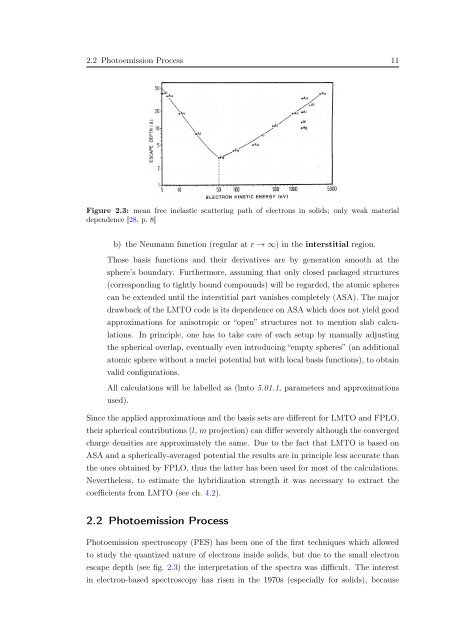Diploma - Max Planck Institute for Solid State Research
Diploma - Max Planck Institute for Solid State Research
Diploma - Max Planck Institute for Solid State Research
Create successful ePaper yourself
Turn your PDF publications into a flip-book with our unique Google optimized e-Paper software.
2.2 Photoemission Process 11<br />
Figure 2.3: mean free inelastic scattering path of electrons in solids; only weak material<br />
dependence [28, p. 8]<br />
b) the Neumann function (regular at r → ∞) in the interstitial region.<br />
Those basis functions and their derivatives are by generation smooth at the<br />
sphere’s boundary. Furthermore, assuming that only closed packaged structures<br />
(corresponding to tightly bound compounds) will be regarded, the atomic spheres<br />
can be extended until the interstitial part vanishes completely (ASA). The major<br />
drawback of the LMTO code is its dependence on ASA which does not yield good<br />
approximations <strong>for</strong> anisotropic or “open” structures not to mention slab calculations.<br />
In principle, one has to take care of each setup by manually adjusting<br />
the spherical overlap, eventually even introducing “empty spheres” (an additional<br />
atomic sphere without a nuclei potential but with local basis functions), to obtain<br />
valid configurations.<br />
All calculations will be labelled as (lmto 5.01.1, parameters and approximations<br />
used).<br />
Since the applied approximations and the basis sets are different <strong>for</strong> LMTO and FPLO,<br />
their spherical contributions (l, m projection) can differ severely although the converged<br />
charge densities are approximately the same. Due to the fact that LMTO is based on<br />
ASA and a spherically-averaged potential the results are in principle less accurate than<br />
the ones obtained by FPLO, thus the latter has been used <strong>for</strong> most of the calculations.<br />
Nevertheless, to estimate the hybridization strength it was necessary to extract the<br />
coefficients from LMTO (see ch. 4.2).<br />
2.2 Photoemission Process<br />
Photoemission spectroscopy (PES) has been one of the first techniques which allowed<br />
to study the quantized nature of electrons inside solids, but due to the small electron<br />
escape depth (see fig. 2.3) the interpretation of the spectra was difficult. The interest<br />
in electron-based spectroscopy has risen in the 1970s (especially <strong>for</strong> solids), because
















